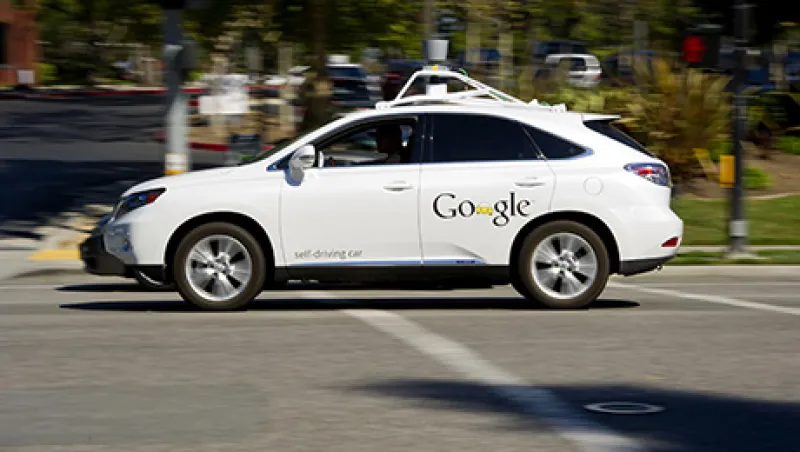For about a decade Google’s self-driving cars have served as an early, and sole, harbinger of a coming age of autonomous driving, a moment when everyone could step into a vehicle and be zipped along like Miss Daisy to their destination — except without her famous chauffeur, or any chauffeur at all. The zippy white pods Google officially rolled out last December have been spotted around Palo Alto and down into Silicon Valley, logging hundreds of thousands of miles of accident-free driving without a human driver behind the wheel. Recently, however, the New York Times reported that those adorable vehicles have a competitor. Transportation company Uber has announced that it also is developing self-driving cars, leading to competition between it and one of the companies that provided its earliest investment.
That makes autonomous driving a space of decided interest for those of us who aren’t Google or Uber. (The latter company is still private, but it continues to attract ever higher valuations, and rumors of an IPO in the next three years have so far proved unsquashable.) The task for investors will be to select those developments within a rapidly developing space — one that will require a change in consumer culture and habits; the fast-paced and continued development of software, hardware and manufacturing; and legal wrangling at the state and federal level. (In California, for instance, Google’s pods had to be retrofitted with controls so that they could be taken over by a human driver at any moment.)
So how does one get a good sense of the goads and the challenges to the adoption of self-driving cars as they appear? Who will win the race, and how do investors take home a piece of the prize?
It’s worth noting at the start that Google has one advantage over all comers: its data. Uber itself uses Google Maps and the company’s array of navigational systems to dispatch its car service. Any self-driving car needs to know where it’s going and calculate both its route and respond in real time to road conditions, traffic, weather, stoplights and so forth. As with electric cars, self-driving cars will need to be supported by new infrastructure: not charging stations — or not solely those, since it seems likely many autonomous vehicles will be electric — but data. Waze, an Israeli start-up now folded into Google, has expanded into what has been called social neogeography: The app provides directions based on input from drivers, including real-time knowledge of traffic congestion. Cell phone handset company Nokia, too, has entered into the mapping game: a division called HERE uses satellite imagery and 3-D laser scanning arrays called lidar to let self-driving cars locate themselves and move with extreme responsiveness and accuracy.
One might also look to sensor manufacturers like Princeton Lightwave, a leader in photosensors and laser arrays that is developing and refining its technology for private industry and for the military. Then there are of course the automobile manufacturers: Mercedes-Benz introduced a cruise-control-like system for driving in congestion and is working on the F 015, a self-driving car that premiered at the International Consumer Electronics Show in Las Vegas in January and is less a vehicle than a “mobile living space.” According to industry press, other manufacturers have begun to use information systems that would enable self-driving cars to assist — not replace — drivers, handling driving during treacherous conditions or taking over the wheel in moments of driver error. These manufacturers include Volvo, unsurprisingly, whose brand is strongly affiliated with safety. BMW, by contrast, seems to have come out against autonomous driving; its CEO insisted that “sheer driving pleasure” — which by his definition is unassisted human driving — will continue to guide development at the company.
The most interesting entry into the fray here might be Nissan, which recently partnered with NASA for the development of self-driving car technology to be used on expeditions on other planets. But aside from the titans of the automobile industry (a funny phrase, given that the automobile industry may evolve past all recognition in the next ten or 20 years), there is also a handful of start-ups in the autonomous driving space whose growth and innovations might provide insight into coming trends. These include the San Francisco–based Cruise Automation. The company mounts an array of sensors onto existing cars. All navigation and control of the vehicle is handled by the Cruise system, though drivers have to stay alert and be able to drive again at any time, rendering it unclear exactly what the product in its current iteration offers customers — not least because it sports a $10,000 price tag.
The wildcard may be Apple, which reportedly has experimented with a self-driving vehicle code-named Titan but which pundits are calling the iCar. “While it appears Apple is serious about at least experimenting in the car space, we believe it is unlikely that the company launches anything in the next five years,” Piper Jaffray analyst Gene Munster told USA Today over the weekend. Whether Google, Uber or Apple will nose out in front of the competition has yet to be seen. But the developments here should come fast and furious, with great gain for those who know where to place their bets. Google, seemingly of the “Heads we win; tails you win, and we take half” school of strategy, has already placed its bet — making its largest ever strategic investment back in 2013, in Uber.






